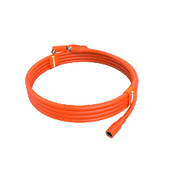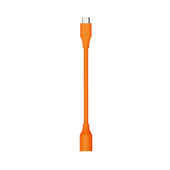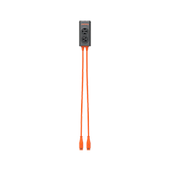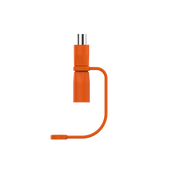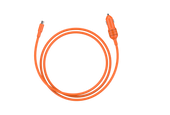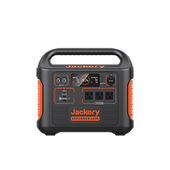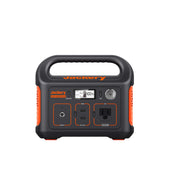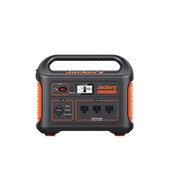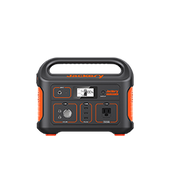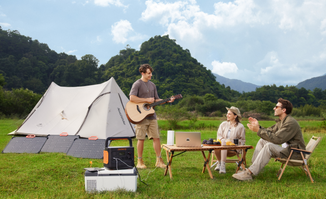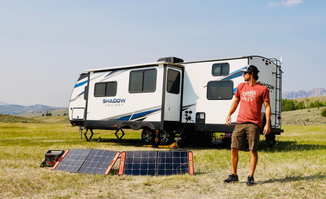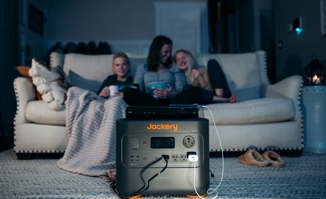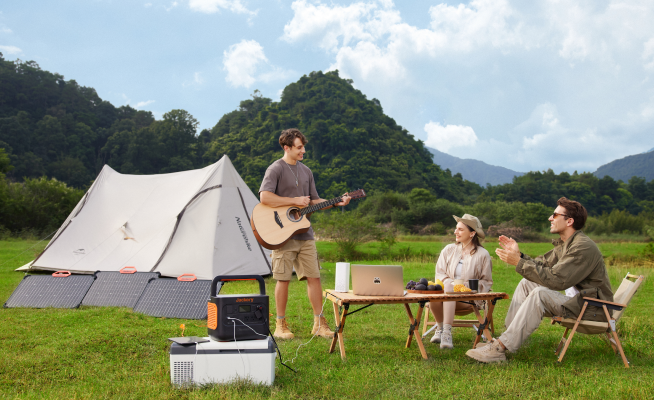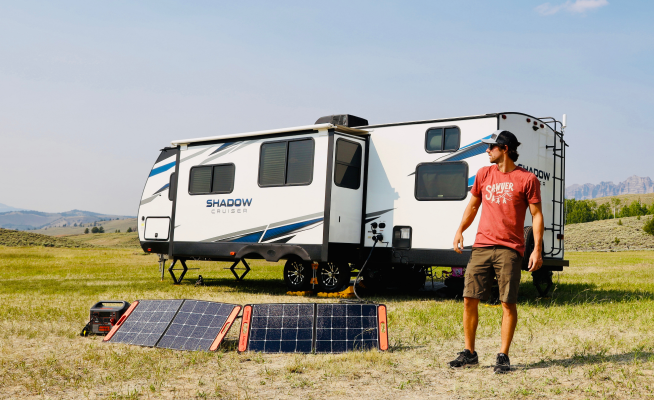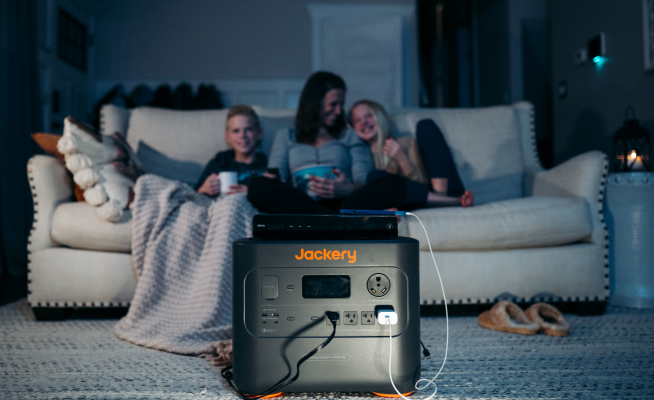The Ultimate Guide To Solar Panel Wires & Cables
Electricity costs are soaring, making it important for homeowners to look for an alternative power solution to charge their appliances. Solar power systems are a go-to option for switching to solar energy and reducing carbon footprints. However, many buyers neglect the most crucial component of the solar system — solar panel wires and cables that attach solar panels to the power station.
Whether you already have a portable power station at home or are planning to buy one, it's worth understanding the different types of solar cables available on the market. Some common types include PV wire, THHN wire, and USE-2 wire. Filmed with PVC material, Jackery DC Extension Cables for solar panels produce less resistance and deliver fast currents to charge the power station faster, making them the best wires in the market.

In this guide, we'll walk you through the basics of solar panel wires, how to classify them based on different factors, their types, and how to select the correct size solar panel wire in 2023.
What Are The Solar Wires?
Solar wires (or cables) are electrical conductors that connect the photovoltaic cells within the solar panels to the rest of the solar power system. They carry the direct current generated by solar panels to the inverter or battery in the power station. Then, the DC electricity is converted to AC electricity used to charge appliances like refrigerators, air conditioners, electrical grills, etc.
The DC extension wire (cable) helps extend the electrical connection from the solar panels to the rest of the system. With the help of an extension cable, you can place the power station inside your home and conveniently connect it to the solar outside. Thanks to their convenient and flexible nature, DC extension wires are suitable for outdoor campers, RVs, or motorhomes.
How To Classify The Solar Panel Wires?
Using the correct type of solar panel wire will make your solar system efficient. However, there are several factors to consider, including but not limited to composition, material, insulation, color, thickness, and length.
Solar Panel Wires Classified By Composition
Based on composition, solar panel wires can be classified into two types — single and stranded.
The solid or single wire consists of one metal wire core. In this type of wiring, the protective sheath insulates the single wire. However, there are a few bare wires too. They are more compact in diameter, cost less, and are available only in small gauges.
Meanwhile, stranded wire contains multiple stranded conductors. Several conductors twisted together and covered with jackets to form a multi-strand wire. It is flexible, larger in diameter, and offers better conductivity than a single wire.
Solar Panel Wires Classified By Materials
Based on the type of material, the solar panel wires are categorized into copper and aluminum wires.
The copper wire carries more current than aluminum, as it has better conductivity, flexibility, and heat resistance. That said, a thin copper wire can carry more current than an aluminum wire of the same size.
Even though aluminum solar wires are cheaper, they are weak and less resistant to high/low temperatures.
Remember, wiring is the part where you should not cut corners. Therefore, choosing wires embedded with a premium copper core is best to keep your solar system safe and increase its lifespan.
Solar Panel Wires Classified By Insulation
Insulation is the sheath that protects the solar cable from the elements, such as heat, chemicals, moisture, ultraviolet light, and water.
Different insulation types, including but not limited to THHN, TW, THW, THWN, UF, USE, and PV, are available on the market. For example, THHN insulation is suitable for dry indoor conditions. Meanwhile, TW, THW, and THWN are installed in wet, outdoor, or indoor conditions.
PV and USE-2 solar cables are two widely used insulations for solar panels. They are capable of withstanding moist and harsh outdoor conditions. In addition, the jackets of PV can handle extreme UV exposure and have an added layer of insulation for extra protection.
Solar Panel Wires Classified By Color
The electrical wire insulation is color coded, which defines its specific function and use. The wiring label differs depending on alternating current and direct current. Understanding the colors of solar panel wires will help you during troubleshooting and repair. Below is the quick color coding guide to help you learn the color wiring better.
|
Alternating Color (AC) |
Direct Current (DC) |
||
|
Color |
Application |
Color |
Application |
|
Green or Bare |
Equipment Ground |
Green or Bare |
Equipment Ground |
|
White |
Grounded Conductor |
White |
Negative or Grounded Conductor |
|
Red, Black, or Other Color |
Un-grounded Hot |
Red |
Positive |
Solar Panel Wires By Thickness
The thickness of the solar wire directly depends on the solar panels' amperage (current) capacity. For instance, if the solar power panel has high amperage, you'll need to purchase a thick wire to handle the load.
In fact, choosing a thin wire for a high-capacity solar panel can cause voltage drop, overheating, and increased risk of free.
Solar Panel Wires Classified By Length
Aside from other factors, considering the length of the solar panel is critical. Always purchase a solar wire that is a little thicker, especially when you want to run it an extra length.
Remember, the suitable solar panel wire choice will depend on all the above factors. If you're looking to choose the best solar wire for your solar power system, consider selecting a PV wire made with premium copper.
The Types Of Solar Panel Wires
Now that you know the factors you'll need to consider to choose the compatible solar wire for your system, here are a few different types of wires available.
Below we have listed all the types of solar panel wires.
THHN
Thermoplastic High Heat-resistant Nylon-coated is a stranded copper wire coated with thermoplastic insulation and a nylon outer jacket. It is commonly used for electrical wiring in homes and buildings.
THW
Thermoplastic Heat and Water-resistant wire is quite similar to THHN but has an additional water-resistant outer jacket. They are commonly used during outdoor applications.
THWN
Thermoplastic Heat and Water-resistant Nylon-coated wire are similar to THW. However, what makes it different is the additional nylon layer of protection. This type of wire is used in moist and damp environments.
TW
Unlike THHN, Thermoplastic Insulated does not have an outer jacket for protection. Therefore, this type of wire is used for interior electrical wiring.
UF and USE
UF (Underground Feeder) and USE (Underground Service Entrance) are specially designed for underground electrical systems with durable and water-resistant insulation.
USE-2 and RHW-2
USE-2 (Underground Service Entrance Type 2) is the improved version of USE wire with enhanced heat resistance, commonly used in warmer climates. RHW-2 is a USE-2 type with flame-retarded properties used in commercial and industrial applications.
PV Wire
PV wire is the widely used solar power wire for interconnection wiring in photovoltaic systems. It features XLPE insulation that makes it UV, sunlight, and moisture resistant. Furthermore, it is durable and specially designed to withstand harsh environmental conditions.
PV Wire VS. USE-2 Wire
PV and USE-2 wires are widely used in photovoltaic systems. However, this does not mean that both are the same. So, what are the basic differences between the two wires, and which one should you choose over the other?
- PV wire is specially designed for interconnections in solar systems. On the other hand, USE-2 is developed for underground service entrances, direct burial, utility, and general wiring applications.
- USE-2 comes with a 600V voltage rating, whereas PV cables are available in different ratings, including 600V, 1000V, and 2000V.
- PV wires are flexible as they have stranded conductors. Meanwhile, not all the USE-2 wires are rated for high flexibility.
- PV wires are highly resistant to flames, whereas USE-2 types have better resistance characteristics.
- USE-2 wire has a 90°C temperature rating, making it suitable for dry and wet conditions. On the other hand, PV wire has a temperature rating of 150°C. That's why it's ideal for extreme temperatures.
For the best result, you'll need to consider the temperature requirements of your solar system, the voltage needs, etc., and then pick the compatible solar panel wire.
Comparisons Of All Solar Panel Wires Types
Here is a quick comparison of all solar panel wires types.
|
Type |
Name |
Insulation |
Outer Covering |
Max. Provisions |
Application |
|
THHN |
Thermoplastic High Heat-resistant Nylon-coated |
Flame retardant and heat-resistant thermoplastic. |
Nylon jacket or equivalent |
90°C, 194 F |
Dry or damp locations |
|
THW |
Thermoplastic Heat and Water-resistant |
Flame retardant, moisture, and heat resistant thermoplastic. |
None |
75-90°C, 167-194 F |
Dry or wet locations |
|
THWN |
Thermoplastic Heat and Water-resistant Nylon-coated |
Flame retardant, moisture, and heat resistant thermoplastic. |
Nylon jacket or equivalent |
75°C, 167 F |
Moist and damp conditions |
|
TW |
Thermoplastic Insulated |
Flame retardant and heat resistant thermoplastic. |
None |
60°C, 140 F |
Interior electrical wiring |
|
UF and USE |
Underground Feeder and Underground Service Entrance |
Moisture and heat resistant. |
Integral with insulation and Moisture resistant |
60-75°C, 140-167 F |
Underground electrical system |
|
USE-2 and RHW-2 |
Underground Service Entrance Type 2 |
High moisture and heat resistant. |
Moisture resistant with insulation |
90°C, 194 F |
Warmer climate and in industrial/commercial applications |
|
PV Wire |
Photovoltaic Wire |
Moisture and heat resistant. |
Moisture resistant with insulation |
90° C (194F) wet, 150° C (302 F) dry |
Dry, wet, or harsh weather conditions. |
What Are The Solar Cables?

Solar cables combine several insulated wires enveloped by a protective outer jacket. They can handle high UV radiation, extreme weather conditions, and high temperatures. The three common types of cables in the solar power system include DC solar cables, solar AC connection cables, and solar DC main cables.
- DC Solar Cable
The DC solar cables are single-core copper cables with sheathes and insulation. They are used within the photovoltaic solar panels and are usually pre-built into the solar panels.
- Main DC Cable
These cables connect the positive and negative wires from the generator to the central inverter. Typical sizes of main DC cables include 2mm, 4mm, 6mm, and 8mm.
- AC Connection Cable
The AC connection solar cable connects the solar inverter to the protection device and electricity grid.
How To Select The Right Solar Panel Wire Size?
Finding the right solar panel wire size is crucial to improve the efficiency of your solar power system. If you are confused about choosing the proper wire size, here are the four steps you need to follow.
- Find The Size Of The Solar Array
The total wattage of your solar panels is the most crucial factor in determining the wire sizes you'll need for your solar system. Remember, the larger the wattage of solar panels, the thicker the wires should be.
- Calculate Max Amps
Depending upon the amps produced by the solar panel, you can calculate the maximum amps or current produced by the solar array. If you combine two or more solar panels in parallel, add the amps of each solar panel. However, if you place the solar panels in series, the total max amps produced will equal the amps generated by the single panel.
- Divide Total Solar Array By 12
Now it's time to divide the total wattage of the solar array by 12 and round it up to the nearest 10. For instance, if you are using 2 * 200 W solar panels with the power station, the total wattage of the solar array will be 400 W. Dividing it by 12 gives you 33.3 A. Hence, you'll need to have a 34 A charge controller.
- Figure Out The Distance
Depending upon the rating of the charge controller, you can choose the size of the wires. The ideal solar wire size will directly correspond to the ampere rating of the solar charge controller. You'll need to consider the distance between the panels and the inverter. If the distance is large, you'll need to choose a long, thick wire size.
Check out this simple-to-read table and choose the solar cable size that fits your solar system needs.
|
AWG |
14 |
12 |
10 |
8 |
6 |
4 |
|
Capacity (AMPs) |
15 |
20 |
30 |
40 |
55 |
70 |
|
System (AMPs) |
One-way distance for a pair of wires ( in feet) |
|||||
|
1 |
45 |
70 |
115 |
180 |
290 |
456 |
|
2 |
22.5 |
35 |
57.5 |
90 |
145 |
228 |
|
4 |
10 |
17.5 |
27.5 |
45 |
72.5 |
114 |
|
6 |
7.5 |
12 |
17.5 |
30 |
47.5 |
75 |
|
8 |
5.5 |
8.5 |
11.5 |
22.5 |
35.5 |
57 |
|
10 |
4.5 |
7 |
9.5 |
18 |
28.5 |
45.5 |
|
15 |
3 |
4.5 |
7 |
12 |
19 |
30 |
|
20 |
2 |
3.5 |
5.5 |
9 |
14.5 |
22.5 |
|
25 |
1.8 |
2.8 |
4.5 |
7 |
11.5 |
18 |
|
30 |
1.5 |
2.4 |
3.5 |
6 |
9.5 |
15 |
|
40 |
|
|
2.8 |
4.5 |
7 |
11.5 |
|
50 |
|
|
2.3 |
3.6 |
5.5 |
9 |
Jackery Solar Panels & Wire
Jackery SolarSaga Solar Panels are made with monocrystalline silicon solar cells, making them extra efficient. With a high solar conversion efficiency of 25%, it's ideally suited for all weather conditions and outdoor activities. Teaming up the solar panels with Jackery Explorer Portable Power Station, you can harness the full power of the sun's energy into electricity.
The multi-layered technology maximizes the efficiency of Jackery SolarSaga solar panels compared to other conventional panels. The best part about Jackery Solar Generator is that it is portable in nature, making it ideal for unexpected power outages, off-grid living, camping, etc. You can extend Jackery's portable power station and solar panel distance using 16.4 feet Jackery DC Extension Cable (sold separately).
Here is a quick comparison table with the best Jackery SolarSaga Solar Panels and compatible Explorer Portable Power Stations.
|
Products |
Compatible with |
Conversion Efficiency |
Input & Output Ports |
Specialty |
|
Jackery Explorer 240/500/1000 power station. |
24.3% |
USB-A Output: 5V, 2.4A USB-C Output: 5V, 3A |
The ETFE-laminated case of the solar panels extends its lifespan and makes it extra durable. The lightweight, IP68 waterproofing abilities and foldable nature make it easier to carry during off-grid adventures. Multi-layered technology makes solar panels highly efficient. |
|
|
All the Jackery power stations. |
25% |
— |
Upgraded and dual-sided panels generate electricity from both sides. It is TÜV SÜD's prestigious IEC TS63163 certified and has passed 15 professional tests. Made of 2.8mm low iron toughened glass, the panels are highly durable. |
Solar Panel Wires FAQs
Now that we have discussed solar panel wires in detail, here are a few frequently asked questions by buyers.
How much wattage do solar panel wires need?
The wattage of the solar panel wires will depend on the number of solar panels you plan to attach to the power station and the distance between them. It's worth noting that wires with higher wattage capacity than required will keep your solar panels running efficiently.
What is the most commonly used solar wire?
The most commonly used solar wire is filmed with PVC material. The wire is designed to withstand harsh conditions and UV exposure and protect the entire solar system from temperature fluctuations.
How to protect your solar panel wires?
To protect your solar panel wires, you can follow these simple steps:
- Use a weather-resistant conduit to protect the wires from outdoor elements, such as snow, rain, and UV radiation.
- Insulate the wires to prevent electrical shorts and protect against potential electrical hazards.
- Fasten to secure the wires and prevent them from shifting or damaging the connections.
- Seal the entry and exit points to prevent water and debris from entering.
How do Jackery solar panel wires work?
Jackery solar panel wires are electrical conductors that connect solar panels to the inverter or other components of the solar power system. They work by transmitting the electrical energy generated by the solar panels to the inverter, which converts DC to AC electricity.
The DC extension cable is compatible with Jackery Solar Generator. It is one of the energy-efficient ways to go off-grid and harness the maximum power of the sun's energy. It combines Jackery SolarSaga Solar Panels and Explorer Portable Power Stations, so you can use solar energy to charge your appliances.
Final Thoughts
Many homeowners are investing in solar generation solutions to reduce their carbon footprint and high electricity bills. However, to ensure your solar generator works efficiently and charges indoor or outdoor appliances, it's vital to pick the right size solar cable.
If you're still apprehensive about which solar panel wire you should choose, consider Jackery DC Extension Cable for solar panels. It is flame-retardant and durable, making it suitable for all outdoor adventures.
Don't forget to sign up for Jackery's newsletter and get instant updates about exclusive deals, promotions, and product news.
Disclaimer:
The runtime mentioned for appliances powered by Jackery is for reference only. Actual runtime may vary under different conditions. Please refer to real-world performance for accurate results.






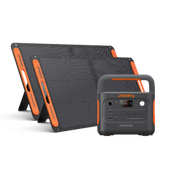


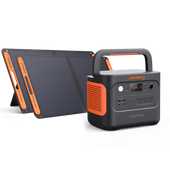

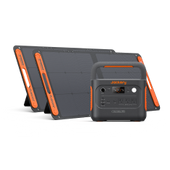
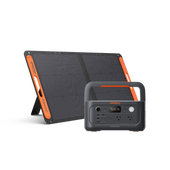
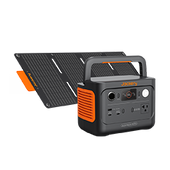
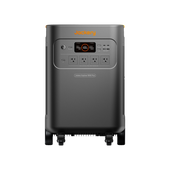
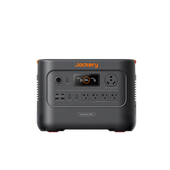
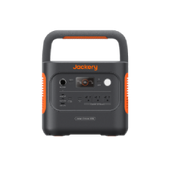
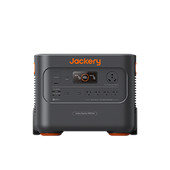
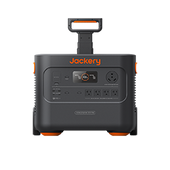

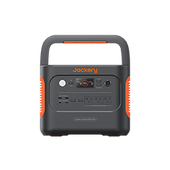
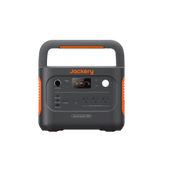
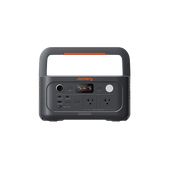

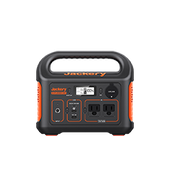
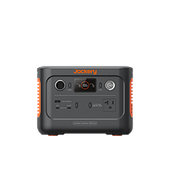
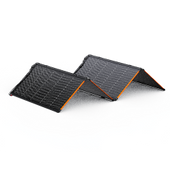
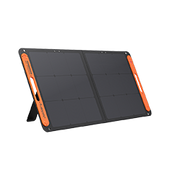

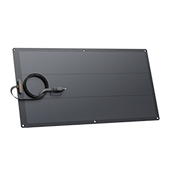
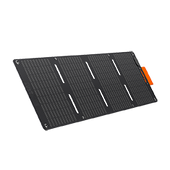
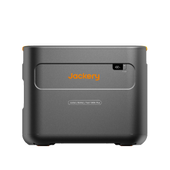
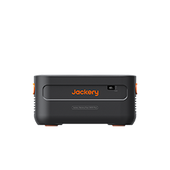
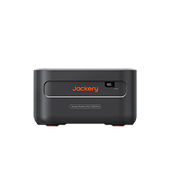
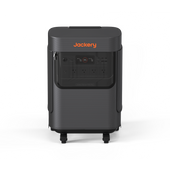
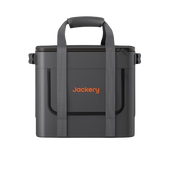
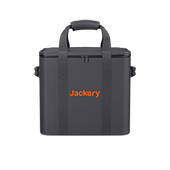
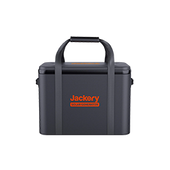
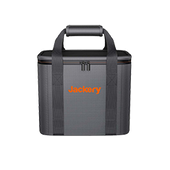
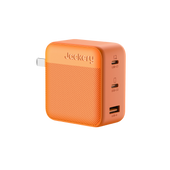
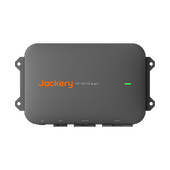
![[Add-on] Jackery Manual Transfer Switch for Explorer 5000 Plus](http://ca.jackery.com/cdn/shop/files/add-on-jackery-manual-transfer-switch-for-5000-plus-240V.webp?v=1757043692&width=170)
